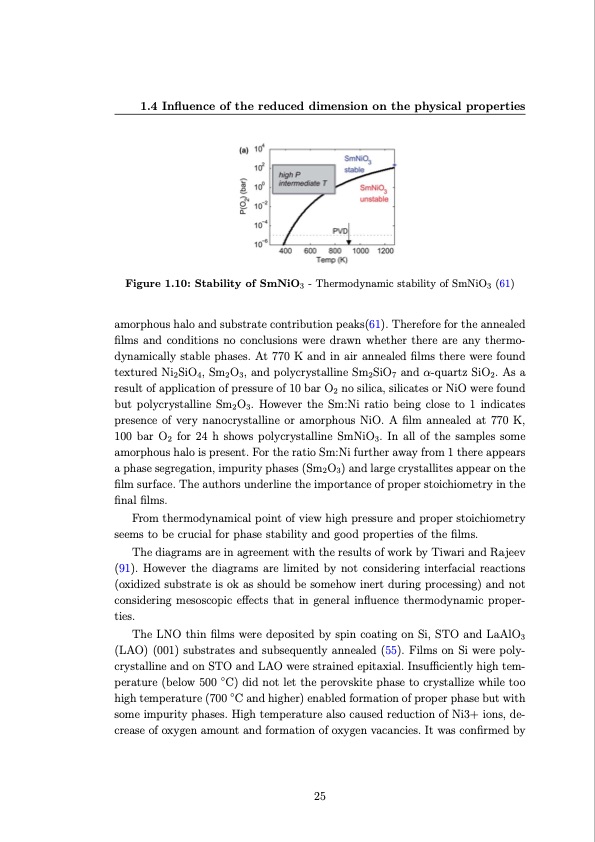
PDF Publication Title:
Text from PDF Page: 046
1.4 Influence of the reduced dimension on the physical properties Figure 1.10: Stability of SmNiO3 - Thermodynamic stability of SmNiO3 (61) amorphous halo and substrate contribution peaks(61). Therefore for the annealed films and conditions no conclusions were drawn whether there are any thermo- dynamically stable phases. At 770 K and in air annealed films there were found textured Ni2SiO4, Sm2O3, and polycrystalline Sm2SiO7 and α-quartz SiO2. As a result of application of pressure of 10 bar O2 no silica, silicates or NiO were found but polycrystalline Sm2O3. However the Sm:Ni ratio being close to 1 indicates presence of very nanocrystalline or amorphous NiO. A film annealed at 770 K, 100 bar O2 for 24 h shows polycrystalline SmNiO3. In all of the samples some amorphous halo is present. For the ratio Sm:Ni further away from 1 there appears a phase segregation, impurity phases (Sm2O3) and large crystallites appear on the film surface. The authors underline the importance of proper stoichiometry in the final films. From thermodynamical point of view high pressure and proper stoichiometry seems to be crucial for phase stability and good properties of the films. The diagrams are in agreement with the results of work by Tiwari and Rajeev (91). However the diagrams are limited by not considering interfacial reactions (oxidized substrate is ok as should be somehow inert during processing) and not considering mesoscopic effects that in general influence thermodynamic proper- ties. The LNO thin films were deposited by spin coating on Si, STO and LaAlO3 (LAO) (001) substrates and subsequently annealed (55). Films on Si were poly- crystalline and on STO and LAO were strained epitaxial. Insufficiently high tem- perature (below 500 ◦C) did not let the perovskite phase to crystallize while too high temperature (700 ◦C and higher) enabled formation of proper phase but with some impurity phases. High temperature also caused reduction of Ni3+ ions, de- crease of oxygen amount and formation of oxygen vacancies. It was confirmed by 25PDF Image | Investigation of metal-insulator transition in magnetron sputtered samarium nickelate thin films

PDF Search Title:
Investigation of metal-insulator transition in magnetron sputtered samarium nickelate thin filmsOriginal File Name Searched:
Bilewska_Investigation_of_metal_insulator_transition_in_magnetron_sputtered_samarium.pdfDIY PDF Search: Google It | Yahoo | Bing
Sulfur Deposition on Carbon Nanofibers using Supercritical CO2 Sulfur Deposition on Carbon Nanofibers using Supercritical CO2. Gamma sulfur also known as mother of pearl sulfur and nacreous sulfur... More Info
CO2 Organic Rankine Cycle Experimenter Platform The supercritical CO2 phase change system is both a heat pump and organic rankine cycle which can be used for those purposes and as a supercritical extractor for advanced subcritical and supercritical extraction technology. Uses include producing nanoparticles, precious metal CO2 extraction, lithium battery recycling, and other applications... More Info
| CONTACT TEL: 608-238-6001 Email: greg@infinityturbine.com | RSS | AMP |